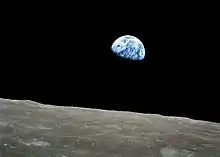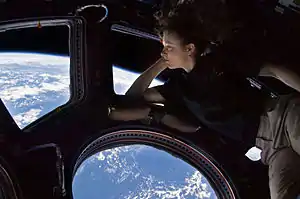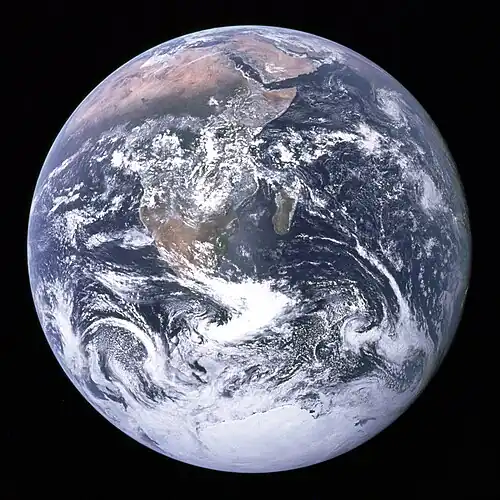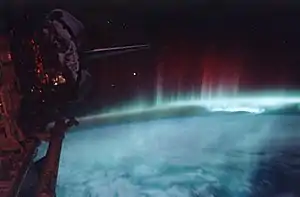Overview effect
The overview effect is a cognitive shift[Note 1] reported by some astronauts while viewing the Earth from space.[2] Researchers have characterized the effect as "a state of awe with self-transcendent qualities, precipitated by a particularly striking visual stimulus".[3] The most prominent common aspects of personally experiencing the Earth from space are appreciation and perception of beauty, unexpected and even overwhelming emotion, and an increased sense of connection to other people and the Earth as a whole.[3] The effect can cause changes in the observer’s self concept and value system, and can be transformative.[3]

Immersive virtual reality simulations have been designed to try to induce the overview effect in earthbound participants.[1][4]
Characteristics

Broadly, Yaden et al. (2016) state that the most prominent common aspects of the astronauts' experience were appreciation and perception of beauty, unexpected and even overwhelming emotion, and an increased sense of connection to other people and the Earth as a whole.[3] Yaden et al. proposed that the overview effect can be understood in terms of awe[Note 2] and self-transcendence,[Note 3] which they describe as "among the deepest and most powerful aspects of the human experience".[3] More specifically, they write that the effect might best be understood as "a state of awe with self-transcendent qualities, precipitated by a particularly striking visual stimulus".[3] Yaden posited that the overview effect triggers awe through both perceptual vastness (like seeing the Grand Canyon) and conceptual vastness (like contemplating big ideas like infinity).[6]
Yaden et al. (2016) write that some astronauts viewing Earth from space "report overwhelming emotion and feelings of identification with humankind and the planet as a whole".[3] The effect can cause changes in the observer’s self concept and value system, and is sometimes transformative.[3] Voski (2020) demonstrated a marked influence on astronauts' environmental attitudes and behaviors, and a new level of environmental awareness and consciousness.[7] Though astronaut Leland Melvin said the effect seems to take hold of astronauts regardless of culture or nation of origin,[8] Yaden et al. observed that cultural differences, including differences in religious and social identity, affect the ways in which the effect is experienced and interpreted.[3] Expressions range from the religious, to the "vaguely spiritual", to the naturalistic, to calls to social duty.[3]
Author Frank White, who in the 1980s coined the term overview effect after interviewing many astronauts, said that the overview effect is "beyond words", requiring experience to understand, even likening it in this regard to Zen Buddhism.[9] He said that astronauts' very first views of the planet were generally very significant, adding that some experience the effect "in a moment" while in others it grows over time; and generally that the effect "does accumulate".[9]
Not all astronauts experience the overview effect.[10] Further, White distinguished experiences in low Earth orbit where the planet takes up most of an astronaut's view, from experiences on the Moon in which one sees the whole Earth "against a backdrop of the entire cosmos".[9] He described a "big difference" between professional astronauts, who are focused on their missions—versus people who have recently been going into space "with an intention to have an experience" and who may already be aware of the overview effect.[11]
Alternative characterizations
Beginning in the 2010s, science historian Jordan Bimm argued against White's interpretation that the overview effect is, in Bimm's words, "a reliably produced mental effect—a naturally occurring phenomenon between the environment and the human mind".[12] Instead, Bimm asserts that the effect is "both a natural and cultural object" that is variable over particular individuals, divergent cultures, and different time periods.[12] Preliminarily, Bimm noted that studies of early test pilots' negative-experience break-off phenomenon ended in 1973 (displaced by White's "positive conversion narrative"), that astronauts in a "lie to fly" culture feel career pressure to avoid reporting negative psychological reactions, and that individuals already aware of the overview effect may make it a self-fulfilling prophecy.[12] He posited that it was Cold War and mastery-of-Earth mentalities of Western technological supremacy that contributed to the rise of borderless-world concepts such as the Gaia hypothesis, spaceship Earth, and the Blue Marble.[12]
Bimm expressed concern over White's perception that the effect embodies a natural imperative for humans to pursue space travel and colonization, Bimm saying the attitude resembles the 18th century American colonialist, expansionist concept of manifest destiny.[12] Bimm warned of hubris underlying a perception of having achieved a new level of enlightenment that he called the "overlord effect".[12]
History

English astronomer Fred Hoyle wrote in 1948 that, "once a photograph of the Earth, taken from the outside, is available, a new idea as powerful as any in history will be let loose".[1] After Apollo 8 astronaut William Anders' December 1968 Earthrise photograph of the Earth from lunar orbit, the Apollo missions were credited with inspiring the environmental movement, the first Earth Day being held in April 1970.[1] Hoyle said that people suddenly seemed to care about protecting Earth's natural environment, though others attribute that awareness to Rachel Carson's 1962 book Silent Spring and reactions to several environmental disasters in the 1960s.[1]
The term overview effect was coined by self-described "space philosopher" Frank White, who said he thought he first had "a mild experience" of the effect while flying across the country and looking out the aircraft's window.[9] That experience led him to imagine living in an O'Neill cylinder (habitat in space), which inspired him to become involved with the Space Studies Institute and begin speaking with astronauts.[9]
White's astronaut interviews confirmed the importance of the difference between intellectual knowledge versus experience, of perceiving the "striking thinness of the atmosphere", of thinking of ourselves interconnected and part of the Earth as an organic system, and that we as different people "are all in this together".[9] The first public use of the term was in a poster at a Space Studies Institute meeting in 1985.[11] Eventually, White wrote about the effect in his book The Overview Effect — Space Exploration and Human Evolution (1987),[13] which has a fourth edition (2021).[11] White's work did not attain broad influence until the 2010s—a period of increased societal divisions and a new prospect of private space travel.[14]
Accounts

Michael Collins,[16] Yuri Gagarin,[6] Ron Garan,[10][17] Chris Hadfield,[18] James Irwin,[6] Mae Jemison,[18] Scott Kelly,[19] André Kuipers,[20] Jerry Linenger,[18] Mike Massimino,[18] Anne McClain,[21] Leland Melvin,[18] Edgar Mitchell,[22] Rusty Schweickart,[22] William Shatner,[23] and Nicole Stott[18] are among those reported to have experienced the effect.
Michael Collins (Apollo 11; 1969) said that "the thing that really surprised me was that it [Earth] projected an air of fragility. And why, I don't know. I don't know to this day. I had a feeling it's tiny, it's shiny, it's beautiful, it's home, and it's fragile.[16]
Edgar Mitchell (Apollo 14; 1971) described it as an "explosion of awareness" and an "overwhelming sense of oneness and connectedness... accompanied by an ecstasy... an epiphany".[3]
William Shatner (Blue Origin NS-18, 2021) said immediately after landing that "everybody in the world needs to do this. ... The covering of blue was... the sheet, this blanket, this comforter of blue that we have around us... And then suddenly you shoot through it... as though you whip off a sheet off you when you’re asleep, and you’re looking into blackness, into black ugliness, and you look down, there’s the blue down there, and the black up there and it’s... Mother Earth and comfort, and there is—is there death? I don’t know".[24]
Lasting impact
Researchers have recognized that awe-based experiences—such as interaction with nature, religious or spiritual or mystical experiences, meditation, and peak and flow experiences during high task performance—can change a person and promote the feeling of unity or interconnectedness.[2] Gallagher et al. (2015) defined a set of consensus categories for awe that included being captured by the view or drawn to the phenomenon, experiences of elation, desiring more of the experience, feeling overwhelmed, and scale effects – feelings of the vastness of the universe or of one’s own smallness when faced with that vastness.[4] Besides being an enjoyable experience, such phenomena can have short and long-term positive outcomes such as increased well-being, pro-social and pro-environmental attitudes, and improved physical health.[2] The self-transcendent experience can cause long-term changes in personal outlook, and can influence peoples' very sense of self by affecting their self-schema[Note 4] ("the particular framework through which (people) imagine themselves in relation to the world").[3]
Specifically, Frank White noted that upon return, some astronauts became involved in humanitarian activities, or became artists, with astronaut Edgar Mitchell founding the Institute of Noetic Sciences.[9] Though Yaden et al. (2016) noted that the experience can be transformative,[3] White said in 2019 that generally there was no "dramatic transformation" or "marching in peace parades"; that the lasting effect was more subtle.[9]
A 2018 questionnaire survey of 39 astronauts and cosmonauts found that humanistic changes predominated over spiritual changes.[25] In particular, the survey found a moderate degree of change in the Perceptions of Earth subscale (Earth as "a beautiful, fragile object to be treasured"), which significantly correlated with subsequent involvement in environmental causes.[25] In contrast, the survey found "no to very small change" in the Spiritual Change subscale, which the researchers said likely reflected established pre-launch values.[25]
Immediately after his October 2021 Blue Origin flight, William Shatner told founder Jeff Bezos, "what you have given me is the most profound experience. I hope I never recover from this. I hope that I can maintain what I feel now".[23] However, in October 2022 he recounted that it took hours for him to realize why he wept after stepping out of the spacecraft: "I realized I was in grief for the Earth".[26] He later said that "I saw more clearly than I have... (the) slow death of Earth and we on it".[27] His biography Boldly Go recounted that "it was among the strongest feelings of grief I have ever encountered. The contrast between the vicious coldness of space and the warm nurturing of Earth below filled me with overwhelming sadness. Every day, we are confronted with the knowledge of further destruction of Earth at our hands... It filled me with dread. My trip to space was supposed to be a celebration; instead, it felt like a funeral."[28]
At one point the Skylab 4 (1970s) crew refused to work, asserting, in the flight director’s words, "their needs to reflect, to observe, to find their place amid these baffling, fascinating, unprecedented experiences".[3] This event, plus research indicating that actively photographing the Earth has positive psychological effects, caused Yaden et al. to posit that studying the overview effect might improve understanding of psychological well-being in isolated, confined, extreme (ICE) environments such as space flight.[3]
Early photos of Earth taken from space have inspired a mild version of the overview effect in earthbound viewers.[1] The images became prominent symbols of environmental concern and have been credited for raising the public's consciousness about the fragility of Earth and expanding concern for long-term survival on a finite planet.[1]
The accumulating experience of astronauts and space tourists inspires in many of them a strong desire to protect the Earth by actively communicating their broadened perspective, for example by speaking at international climate summits.[1] Virgin Galactic officials specifically cite the overview effect as a motivation for carrying people to the edge of space, to fundamentally change the way people think about their home world.[29] Critics note, however, that the space travel needed to personally experience the full overview effect, itself involves significant environmental pollution.[1] A less polluting approach is to simulate the effect on Earth, with virtual reality technology.[1]
Simulating the effect
Researchers have found that virtual reality (VR) technology elicits components of awe-based experiences and can induce minor cognitive shifts in participants' world views similar to those of the overview effect.[2] Perceived safety, personal background and familiarity with the environment, and induction of a small visceral fear reaction, were found to be key contributors to the immersive experience.[2] VR studies through 2019 had not observed a transformative experience on a scale similar to the overview effect itself, but VR experience can trigger profound emotional responses such as awe.[2]

A 2019 study found that a virtual experience invoked "minor transformative experiences in some participants", including appreciation of beauty and vastness, realization of interconnectedness, and a potential intent to change one’s behavior.[2] Recognizing the relatively early state of VR technology, the researchers urged using knowledge of profound transformative experiences to motivate the design of VR installations, and thereafter study the VR experience itself as its own phenomenon.[2]
On December 24, 2018—the fiftieth anniversary of the first day on which humans saw an earthrise with their own eyes—the Spacebuzz project was unveiled in Hilversum, Netherlands.[30] Within a mobile, rocket-shaped vehicle more than 15 metres (49 ft) in length, Spacebuzz's nine moving seats and virtual reality (VR) headsets simulate spaceflight in an experience designed especially for children.[30]
Researchers at the University of Missouri tried to reproduce the experience with a water-filled flotation tank, half a tonne of Epsom salts, and a waterproof VR headset.[10]
"The Infinite" provides an hour-long simulation of being on the International Space Station using 360-degree, 3D, astronaut-recorded footage from the VR film Space Explorers: The ISS Experience.[31] Visitors share a 12,500 square foot (1150 square meter) area allowing them to physically explore the ISS and look outside.[31]
A three-dimensional model of the Earth 7 metres (23 ft) in diameter, created from detailed NASA imagery and appearing to float in the air, toured the U.K. in 2022, the installation "aim(ing) to create a sense of the Overview Effect".[32]
Other names
The overview effect has been referred to as the big picture effect (Edgar Mitchell),[33] orbital perspective (Ronald J. Garan Jr.),[8] and the astronaut's secret (Albert Sacco).[12]
Referring to how profound Mitchell's experience on the Moon was—distinguished from experiences in low Earth orbit—author Frank White called Mitchell's experience universal insight as it had a more universal perspective.[11]
Related effects
A 1957 article in The Journal of Aviation Medicine studied the break-off phenomenon, which it defined as "a feeling of physical separation from the earth when piloting an aircraft at high altitude".[34] Main precipitating factors were concluded to be: flying alone, at high altitude, with relatively little to do.[34] Researchers summarized pilots' descriptions as "a feeling of being isolated, detached, or separated physically from the earth" or as a perception of "somehow losing their connection with the world".[34] Individual reactions ranged from exhilaration or feeling nearer to God, to anxiety, fear, or loneliness.[34] Scientific literature covering the break-off phenomenon ended in 1973.[12]
Anthropologist Deana L. Weibel introduced the term ultraview effect as a response to an unobscured view of stars, an effect that she concluded was experienced more rarely than the overview effect.[35] Contrasted from the overview effect's sense of connection, the ultraview effect responds to the limitations of our knowledge, causing "a transformative sense of incomprehension and a feeling of shrinking or self-diminution".[35]
Frank White posited the term Copernicus Perspective—awareness of being part of the Solar System when one is on another planet.[11]
Science historian Jordan Bimm described how the concept shares similarities with the British concept of the sublime—an experience associated with views from high mountains.[12]
Notes
- The introduction to Stepanova et al. (2019) begins, "The overwhelmingly beautiful sight of our Earth triggers a profound emotional response in most astronauts, leading to a cognitive shift, making them realize the global interconnectedness of all life and feel responsibility for the future of our planet. ... This experience has the attributes of self-transcendence and awe (citing Yaden et al., 2016) and is a remarkable example of a transformative experience.
- Yaden et al. (2016) explain that "social psychologists characterize awe as an intense emotion resulting from the perception of something vast, as well as the subsequent need to accommodate the experience" (citing Keltner & Haidt, 2003). However, they observe that in addition to vastness, a distant view of Earth also suggests totality—with the wholeness of the Earth making it a symbol of almost all that is meaningful in human life, causing a tendency to think, quite literally, in global terms.
- Yaden et al. (2016) posit that the overview effect may trigger self-transcendent experiences (STEs)—"temporary feelings of unity characterized by reduced self-salience and increased feelings of connection" historically associated with practices such as prayer, meditation, religious rituals and psychedelic drug use—feelings that may "arouse visceral feelings of compassion and personal connection... that may encompass the entirety of the Earth and its inhabitants".
- Yaden et al. (2016) explain that a schema is "an organized conceptual framework through which individuals approach new information and make sense of old experiences. Each of an individual's schemas entails a set of memories, beliefs, and attitudes that create a general cognitive orientation, guiding individuals' interpretation of and response to incoming stimuli". When encountering new experiences, people must "accommodate" by expanding their self-schema framework to take new information into account.
See also
References
- Yoder, Kate (February 9, 2022). "The Overview Effect / How the view from space might be key to saving the planet". Grist. Archived from the original on February 10, 2022.
- Stepanova, Ekaterina R.; Quesnel, Denise; Riecke, Bernhard E. (May 22, 2019). "Understanding AWE: Can a Virtual Journey, Inspired by the Overview Effect, Lead to an Increased Sense of Interconnectedness?". Frontiers in Digital Humanities. Frontiers Media. 6. doi:10.3389/fdigh.2019.00009.
- Yaden, David B.; Iwry, Jonathan; Slack, Kelley J.; Eichstaedt, Johannes C.; Zhao, Yukun; Vaillant, George E.; Newberg, Andrew B. (2016). "The overview effect: Awe and self-transcendent experience in space flight". Psychology of Consciousness: Theory, Research, and Practice. 3 (1): 1–11. doi:10.1037/cns0000086. ISSN 2326-5531.
- Gallagher, S., Janz, B., Reinerman, L., Trempler, J., and Bockelman, P. (2015). A Neurophenomenology of Awe and Wonder: Towards a Non-reductionist Cognitive Science. London: Springer.
- White, William Frank (March 12, 2021). "The Overview Effect and Creative Performance in Extreme Human Environments". Frontiers in Psychology. Frontiers Media. 12: 584573. doi:10.3389/fpsyg.2021.584573. PMC 7994510. PMID 33776828.
- Ferreira, Becky (October 12, 2016). "Seeing Earth from Space Is the Key to Saving Our Species from Itself". Vice (magazine). Archived from the original on April 6, 2022.
- Voski, Anaïs (2020-08-01). "The ecological significance of the overview effect: Environmental attitudes and behaviours in astronauts". Journal of Environmental Psychology. 70: 101454. doi:10.1016/j.jenvp.2020.101454. ISSN 0272-4944.
- Dickinson, Kevin (November 3, 2021). "The awesome power of awe: How this neglected emotion can change lives". Big Think. Archived from the original on August 29, 2022.
- White, Frank; Jordan, Gary (August 30, 2019). "The Overview Effect". NASA. Archived from the original on August 23, 2022.
- Sample, Ian (December 26, 2019). "Scientists attempt to recreate 'Overview effect' from Earth". The Guardian. ISSN 0261-3077. Archived from the original on December 27, 2019 – via www.theguardian.com.
- David, Leonard (August 2, 2022). "Space philosopher Frank White on 'The Overview Effect' and humanity's connection with Earth". Space.com. Archived from the original on August 9, 2022.
- Bimm, Jordan (February 1, 2014). "Rethinking the Overview Effect". Quest: The History of Spaceflight. 21 (1): 39. Archived from the original on November 17, 2014. ● (PDF)
● Audio of Bimm's related oral presentation, hosted by Boucher, Marc (September 6, 2021). "Rethinking the Overview Effect". SpaceQ.ca. Archived from the original on October 22, 2022. - David, Leonard (August 5, 2006). "Space Tourism: Face Time with Earth". Space.com. Archived from the original on November 24, 2006.
- Guttman, Leslie (January 28, 2021). "Can Astronaut Thinking Heal America At Last?". Ozy. Archived from the original on May 7, 2022.
- "Image of the Day Gallery / Thin Blue Line". NASA.gov. November 25, 2009. Archived from the original on November 27, 2009.
- Chang, Kenneth (July 16, 2019). "For Apollo 11 He Wasn't on the Moon. But His Coffee Was Warm". The New York Times. ISSN 0362-4331. Archived from the original on July 17, 2019.
- "Orbital Perspective: Astronaut Ron Garan Explains How to Save the Planet". NBC News. February 3, 2015. Archived from the original on April 15, 2021.
- Hadfield, Chris; Linenger, Jerry; Stott, Nicole; Jemison, Mae; Melvin, Leland; Massimino, Mike (March 27, 2018). "Six NASA Astronauts Describe the Moment in Space when 'Everything Changed'". Inverse.com. Archived from the original on March 31, 2018.
- Feloni, Richard (March 19, 2018). "NASA astronaut Scott Kelly explains how seeing planet Earth from space changed his perspective on life". Business Insider. Archived from the original on March 17, 2018.
- Williams, Matthew S. (June 9, 2019). "The Overview Effect: Seeing Earth from Above Can Inspire Change". Interesting Engineering. Archived from the original on September 24, 2022.
- Solsman, Joan E. (April 11, 2022). "'The Infinite' VR Is the Closest You'll Feel to Space Without Floating". CNET. Archived from the original on September 14, 2022. ● Video: "Astronaut describes seeing sunrise from Space for first time". CNN on YouTube. April 27, 2020. Archived from the original on April 28, 2020.
- O'Neill, Ian (May 22, 2008). "The Human Brain in Space: Euphoria and the "Overview Effect" Experienced by Astronauts". Universe Today. Archived from the original on January 28, 2019.
- "William Shatner, TV's Capt. Kirk, blasts into space". AP News. October 13, 2021. Archived from the original on October 13, 2021.
- Kvetenadze, Téa (October 13, 2021). "'Whoa, That's Death!' Here's Everything William Shatner Said To Jeff Bezos After Returning From Space (transcript)". Forbes. Archived from the original on October 13, 2021. (pay wall; can use archive link)
- Kanas, Nick (January 2020). "Spirituality, humanism, and the Overview Effect during manned space missions". Acta Astronautica. 166: 525. Bibcode:2020AcAau.166..525K. doi:10.1016/j.actaastro.2018.08.004. S2CID 115759115.
- Wattles, Jackie (October 10, 2022). "William Shatner on traveling to space: 'All I saw was death'". CNN. Archived from the original on October 14, 2022.
- Rivera, Enrique (October 23, 2022). "William Shatner experienced profound grief in space. It was the 'overview effect'". NPR. Archived from the original on November 22, 2022.
- Shatner, William (October 6, 2022). "William Shatner: My Trip to Space Filled Me With 'Overwhelming Sadness'". Variety. Archived from the original on October 11, 2022.
- Wall, Mike (February 11, 2019). "The View from Space Could Change the World, Virgin Galactic Says". Space.com. Archived from the original on May 6, 2022.
- "Onthulling SPACEBUZZ, een innovatief VR-educatieprogramma" [Unveiling SpaceBuzz, an innovative VR program]. ESA.int (in Dutch). December 20, 2018. Archived from the original on September 13, 2021.
● "Spacebuzz - Creating ambassadors of planet Earth". SpaceBuzz. Archived from the original on December 22, 2019. - Karwacki, Jean-Pierre (August 2, 2021). "'The Infinite' Virtual Reality Exhibit Offers a Taste of Life in Outer Space". Time. Archived from the original on August 2, 2021.
- Mansfield, Ian (August 23, 2022). "Gaia – a large glowing earth will float inside Southwark Cathedral". IanVisits.com tourist website. Archived from the original on August 23, 2022.
- Simpson, Dave (February 11, 2016). "The Metaphysical Astronauts". Vice (magazine). Archived from the original on August 16, 2022.
- Clark, Brant; Graybiel, Ashton (April 1957). "The Break-off Phenomenon / A Feeling of Separation from the Earth Experienced by Pilots at High Altitude" (PDF). The Journal of Aviation Medicine. 28 (2): 121–126. PMID 13416151. (archive)
- Weibel, Deana (August 13, 2020). "The Overview Effect and the Ultraview Effect: How Extreme Experiences in/of Outer Space Influence Religious Beliefs in Astronauts". Religions. 11 (8): 418. doi:10.3390/rel11080418. S2CID 225477388.
External links
- Overview Institute
- Overview, short film from Planetary Collective
- Speech on The Overview Effect and its Importance in Civilization, 5 minute talk by JP Chastain at Ignite Boise (2012)
_-_DPLA_-_0e4d63ab3ecd3df1d963ed55c4a3fe85.jpg.webp)
